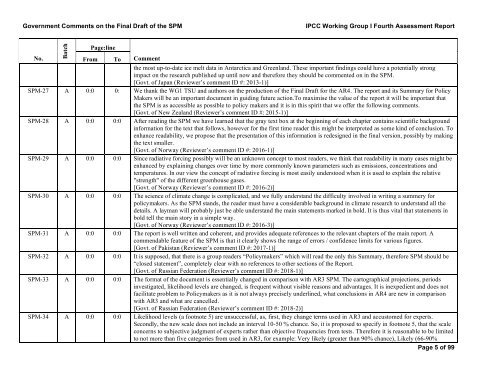Government Comments on the Final Draft of the SPM IPCC Working ...
Government Comments on the Final Draft of the SPM IPCC Working ...
Government Comments on the Final Draft of the SPM IPCC Working ...
Create successful ePaper yourself
Turn your PDF publications into a flip-book with our unique Google optimized e-Paper software.
<str<strong>on</strong>g>Government</str<strong>on</strong>g> <str<strong>on</strong>g>Comments</str<strong>on</strong>g> <strong>on</strong> <strong>the</strong> <strong>Final</strong> <strong>Draft</strong> <strong>of</strong> <strong>the</strong> <strong>SPM</strong><br />
<strong>IPCC</strong> <strong>Working</strong> Group I Fourth Assessment Report<br />
Batch<br />
Page:line<br />
No.<br />
From To Comment<br />
<strong>the</strong> most up-to-date ice melt data in Antarctica and Greenland. These important findings could have a potentially str<strong>on</strong>g<br />
impact <strong>on</strong> <strong>the</strong> research published up until now and <strong>the</strong>refore <strong>the</strong>y should be commented <strong>on</strong> in <strong>the</strong> <strong>SPM</strong>.<br />
[Govt. <strong>of</strong> Japan (Reviewer’s comment ID #: 2013-1)]<br />
<strong>SPM</strong>-27 A 0:0 0: We thank <strong>the</strong> WG1 TSU and authors <strong>on</strong> <strong>the</strong> producti<strong>on</strong> <strong>of</strong> <strong>the</strong> <strong>Final</strong> <strong>Draft</strong> for <strong>the</strong> AR4. The report and its Summary for Policy<br />
Makers will be an important document in guiding future acti<strong>on</strong>.To maximise <strong>the</strong> value <strong>of</strong> <strong>the</strong> report it will be important that<br />
<strong>the</strong> <strong>SPM</strong> is as accessible as possible to policy makers and it is in this spirit that we <strong>of</strong>fer <strong>the</strong> following comments.<br />
[Govt. <strong>of</strong> New Zealand (Reviewer’s comment ID #: 2015-1)]<br />
<strong>SPM</strong>-28 A 0:0 0:0 After reading <strong>the</strong> <strong>SPM</strong> we have learned that <strong>the</strong> gray text box at <strong>the</strong> beginning <strong>of</strong> each chapter c<strong>on</strong>tains scientific background<br />
informati<strong>on</strong> for <strong>the</strong> text that follows, however for <strong>the</strong> first time reader this might be interpreted as some kind <strong>of</strong> c<strong>on</strong>clusi<strong>on</strong>. To<br />
enhance readability, we propose that <strong>the</strong> presentati<strong>on</strong> <strong>of</strong> this informati<strong>on</strong> is redesigned in <strong>the</strong> final versi<strong>on</strong>, possibly by making<br />
<strong>the</strong> text smaller.<br />
[Govt. <strong>of</strong> Norway (Reviewer’s comment ID #: 2016-1)]<br />
<strong>SPM</strong>-29 A 0:0 0:0 Since radiative forcing possibly will be an unknown c<strong>on</strong>cept to most readers, we think that readability in many cases might be<br />
enhanced by explaining changes over time by more comm<strong>on</strong>ly known parameters such as emissi<strong>on</strong>s, c<strong>on</strong>centrati<strong>on</strong>s and<br />
temperatures. In our view <strong>the</strong> c<strong>on</strong>cept <strong>of</strong> radiative forcing is most easily understood when it is used to explain <strong>the</strong> relative<br />
"strength" <strong>of</strong> <strong>the</strong> different greenhouse gases.<br />
[Govt. <strong>of</strong> Norway (Reviewer’s comment ID #: 2016-2)]<br />
<strong>SPM</strong>-30 A 0:0 0:0 The science <strong>of</strong> climate change is complicated, and we fully understand <strong>the</strong> difficulty involved in writing a summery for<br />
policymakers. As <strong>the</strong> <strong>SPM</strong> stands, <strong>the</strong> reader must have a c<strong>on</strong>siderable background in climate research to understand all <strong>the</strong><br />
details. A layman will probably just be able understand <strong>the</strong> main statements marked in bold. It is thus vital that statements in<br />
bold tell <strong>the</strong> main story in a simple way.<br />
[Govt. <strong>of</strong> Norway (Reviewer’s comment ID #: 2016-3)]<br />
<strong>SPM</strong>-31 A 0:0 0:0 The report is well written and coherent, and provides adequate references to <strong>the</strong> relevant chapters <strong>of</strong> <strong>the</strong> main report. A<br />
commendable feature <strong>of</strong> <strong>the</strong> <strong>SPM</strong> is that it clearly shows <strong>the</strong> range <strong>of</strong> errors / c<strong>on</strong>fidence limits for various figures.<br />
[Govt. <strong>of</strong> Pakistan (Reviewer’s comment ID #: 2017-1)]<br />
<strong>SPM</strong>-32 A 0:0 0:0 It is supposed, that <strong>the</strong>re is a group readers “Policymakers” which will read <strong>the</strong> <strong>on</strong>ly this Summary, <strong>the</strong>refore <strong>SPM</strong> should be<br />
“closed statement”, completely clear with no references to o<strong>the</strong>r secti<strong>on</strong>s <strong>of</strong> <strong>the</strong> Report.<br />
[Govt. <strong>of</strong> Russian Federati<strong>on</strong> (Reviewer’s comment ID #: 2018-1)]<br />
<strong>SPM</strong>-33 A 0:0 0:0 The format <strong>of</strong> <strong>the</strong> document is essentially changed in comparis<strong>on</strong> with AR3 <strong>SPM</strong>. The cartographical projecti<strong>on</strong>s, periods<br />
investigated, likelihood levels are changed, is frequent without visible reas<strong>on</strong>s and advantages. It is inexpedient and does not<br />
facilitate problem to Policymakers as it is not always precisely underlined, what c<strong>on</strong>clusi<strong>on</strong>s in AR4 are new in comparis<strong>on</strong><br />
with AR3 and what are cancelled.<br />
[Govt. <strong>of</strong> Russian Federati<strong>on</strong> (Reviewer’s comment ID #: 2018-2)]<br />
<strong>SPM</strong>-34 A 0:0 0:0 Likelihood levels (a footnote 5) are unsuccessful, as, first, <strong>the</strong>y change terms used in AR3 and accustomed for experts.<br />
Sec<strong>on</strong>dly, <strong>the</strong> new scale does not include an interval 10-50 % chance. So, it is proposed to specify in footnote 5, that <strong>the</strong> scale<br />
c<strong>on</strong>cerns to subjective judgment <strong>of</strong> experts ra<strong>the</strong>r than objective frequencies from tests. Therefore it is reas<strong>on</strong>able to be limited<br />
to not more than five categories from used in AR3, for example: Very likely (greater than 90% chance), Likely (66-90%<br />
Page 5 <strong>of</strong> 99

















